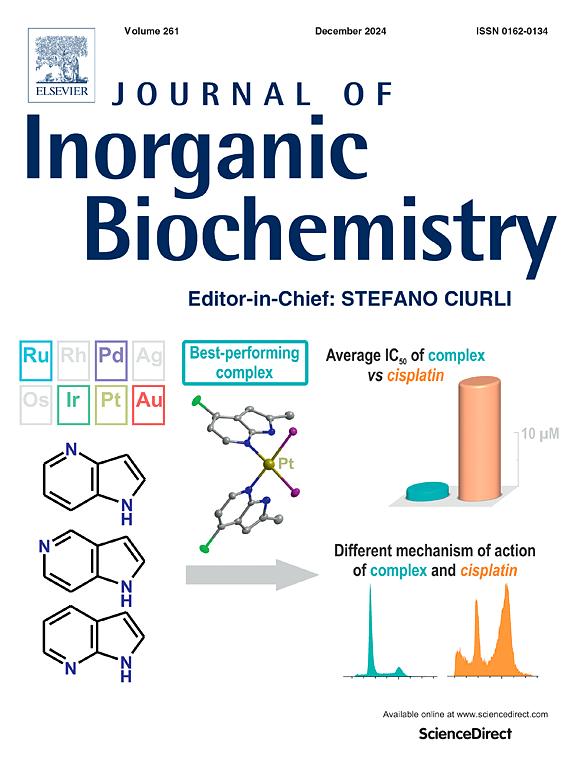Palladium(II) complexes containing andrographolide appended N,O heterocyclic chelators: Investigation of anti-oxidant, anti-cancer and apoptotic activities
IF 3.8
2区 化学
Q2 BIOCHEMISTRY & MOLECULAR BIOLOGY
引用次数: 0
Abstract
A series of new Pd(II) complexes were synthesized from the reaction of andrographolide appended hydrazide derivatives with potassium tetrachloropalladate K2[PdCl4]. The formation of the complexes was confirmed through structural assessments conducted using various spectroscopic techniques. From the spectral studies we confirmed that the ligands coordinated to Pd(II) ion via amine nitrogen and enone oxygen. The complexes were assessed for their antioxidant properties, demonstrating significant radical scavenging activity with a series of free radicals such as 1,1-diphenyl-2-picrylhydrazyl (DPPH•), 2,2′-azinobis-(3-ethylbenzothiazoline-6-sulphonic acid diammonium salt (ABTS•+), Super oxide (O2−) and Nitric oxide (NO•) radicals compared with standard antioxidants. Moreover, in vitro antiproliferative investigations conducted on A549 (human lung cancer) and HeLa (human cervical cancer) cell lines revealed significant cytotoxicity of the complexes, with lower IC50 values compared to the standard metallo-drug cisplatin. Morphological alterations observed in HeLa and A549 cells when treated with IC50 concentrations of the complexes, as examined through Acridine Orange-Ethidium Bromide (AO-EB) and 4′,6-diamidino-2-phenylindole (DAPI) staining techniques, indicated cell death via apoptosis. Biological studies indicated that AGC-Pd exhibited superior activity among others, further the percentages of the apoptotic and necrotic cells were determined by flow cytometric technique.

求助全文
约1分钟内获得全文
求助全文
来源期刊

Journal of Inorganic Biochemistry
生物-生化与分子生物学
CiteScore
7.00
自引率
10.30%
发文量
336
审稿时长
41 days
期刊介绍:
The Journal of Inorganic Biochemistry is an established international forum for research in all aspects of Biological Inorganic Chemistry. Original papers of a high scientific level are published in the form of Articles (full length papers), Short Communications, Focused Reviews and Bioinorganic Methods. Topics include: the chemistry, structure and function of metalloenzymes; the interaction of inorganic ions and molecules with proteins and nucleic acids; the synthesis and properties of coordination complexes of biological interest including both structural and functional model systems; the function of metal- containing systems in the regulation of gene expression; the role of metals in medicine; the application of spectroscopic methods to determine the structure of metallobiomolecules; the preparation and characterization of metal-based biomaterials; and related systems. The emphasis of the Journal is on the structure and mechanism of action of metallobiomolecules.
 求助内容:
求助内容: 应助结果提醒方式:
应助结果提醒方式:


